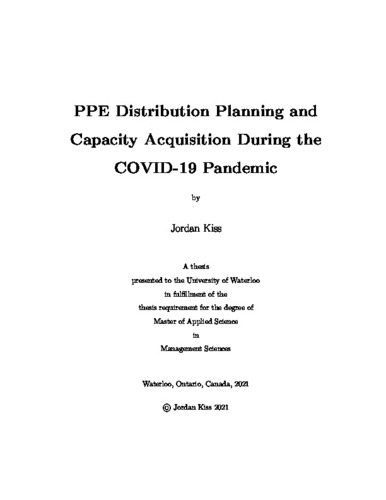| dc.contributor.author | Kiss, Jordan | |
| dc.date.accessioned | 2021-09-27 19:18:27 (GMT) | |
| dc.date.available | 2021-09-27 19:18:27 (GMT) | |
| dc.date.issued | 2021-09-27 | |
| dc.date.submitted | 2021-09-14 | |
| dc.identifier.uri | http://hdl.handle.net/10012/17555 | |
| dc.description.abstract | The COVID-19 pandemic caused disruptions to global supply chains and the uncer- tainty surrounding its progression has created challenges in distributing critical supplies such as personal protective equipment (PPE). We consider the problem of distributing PPE during the COVID-19 pandemic by acquiring distribution and storage capacity from independent carriers for timely and efficiently delivery to health regions. First, a priority- based distribution model is presented that prioritizes health regions by pandemic sever- ity where priorities are based on COVID-19 case counts. Then, we propose a two-stage stochastic model with recourse to examine PPE distribution with uncertain demand. In the first stage, capacity acquisition decisions are made along with an initial distribution plan. Once the pandemic severity unveils, changes to the distribution plan are made in the second stage. The stochastic model is solved using Benders decomposition and approxi- mated using sample average approximation. Benders decomposition and sample average approximation produce similar results with an optimality gap of less than 1%. Benders decomposition requires about 20 minutes to solve, while sample average approximation requires almost an hour. We test on the Ontario health regions network and use the On- tario healthcare worker and COVID-19 data to predict future PPE demand using 1024 scenarios. Comparing the results with actual COVID-19 realizations, we found that the stochastic model provides sufficient PPE to satisfy demand at all regions. Furthermore, only minimum supply is rerouted in the second stage and existing inventory is used to satisfy demand increases where possible. When supply is more spread out amongst the regions, the proportion of demand received at high-priority regions is more balanced, and in the event of supply disturbances, distribution centres are used to stockpile PPE for time periods with low supply. | en |
| dc.language.iso | en | en |
| dc.publisher | University of Waterloo | en |
| dc.title | PPE Distribution Planning and Capacity Acquisition During the COVID-19 Pandemic | en |
| dc.type | Master Thesis | en |
| dc.pending | false | |
| uws-etd.degree.department | Management Sciences | en |
| uws-etd.degree.discipline | Management Sciences | en |
| uws-etd.degree.grantor | University of Waterloo | en |
| uws-etd.degree | Master of Applied Science | en |
| uws-etd.embargo.terms | 0 | en |
| uws.contributor.advisor | Elhedhli, Samir | |
| uws.contributor.affiliation1 | Faculty of Engineering | en |
| uws.published.city | Waterloo | en |
| uws.published.country | Canada | en |
| uws.published.province | Ontario | en |
| uws.typeOfResource | Text | en |
| uws.peerReviewStatus | Unreviewed | en |
| uws.scholarLevel | Graduate | en |

